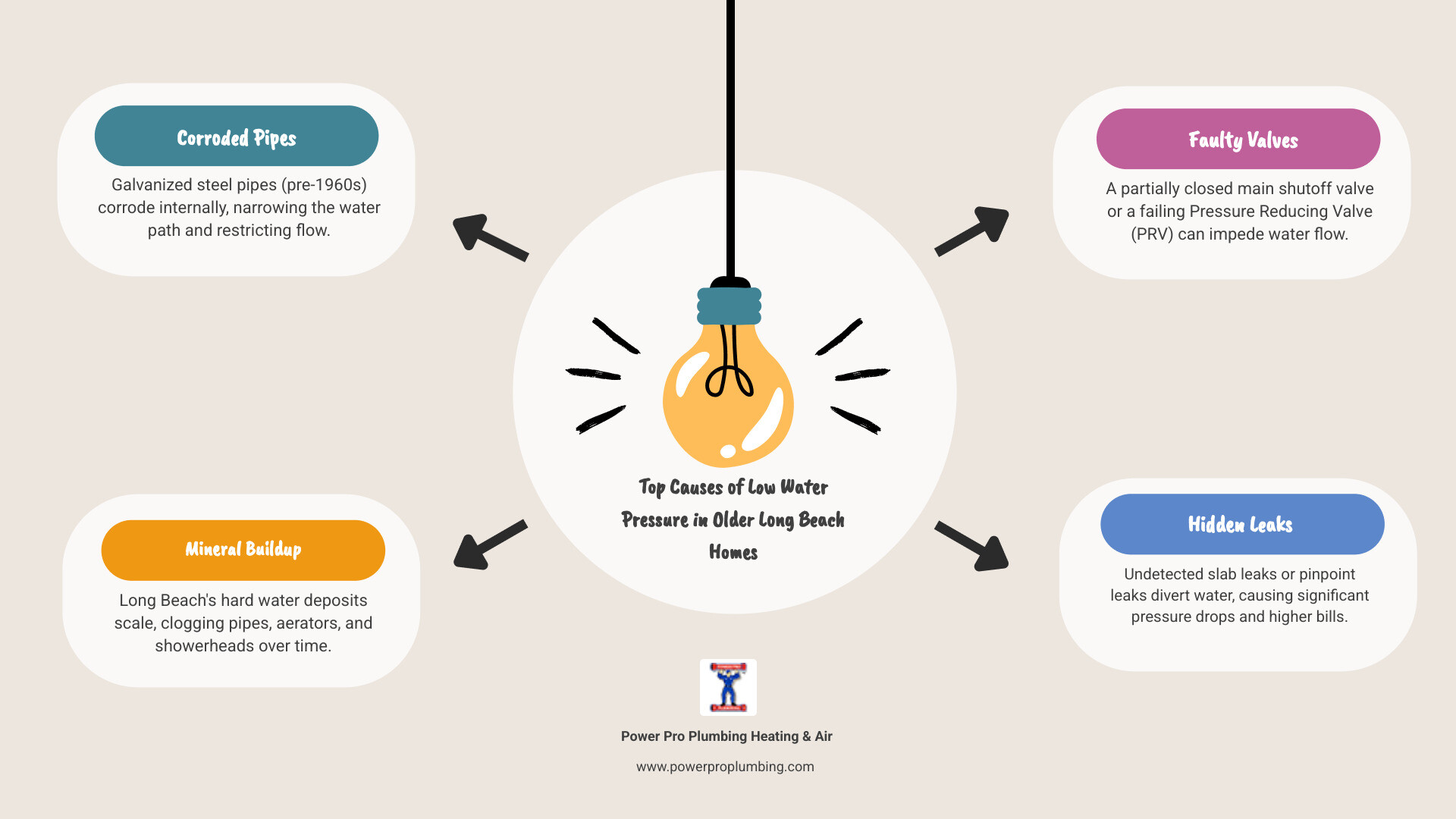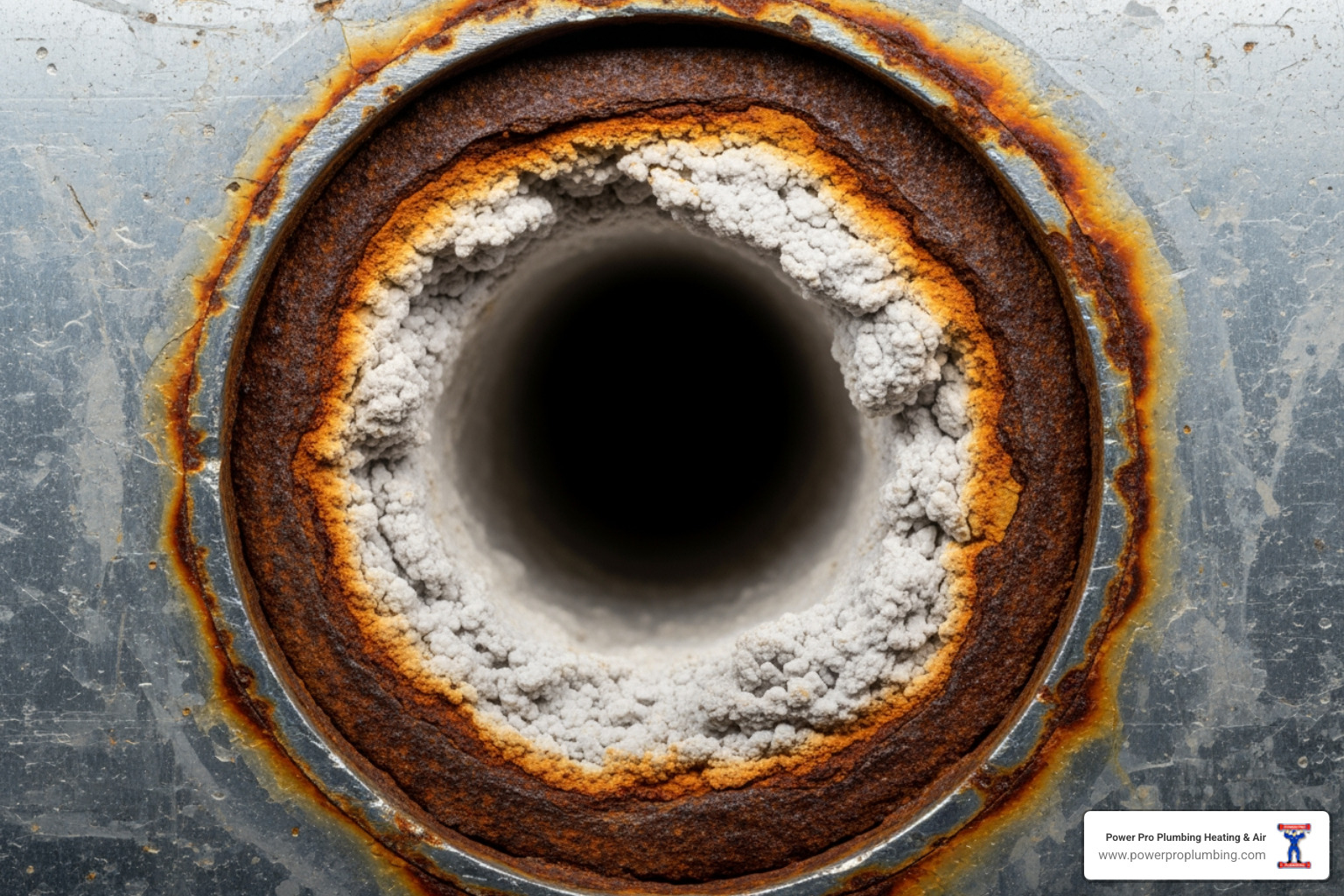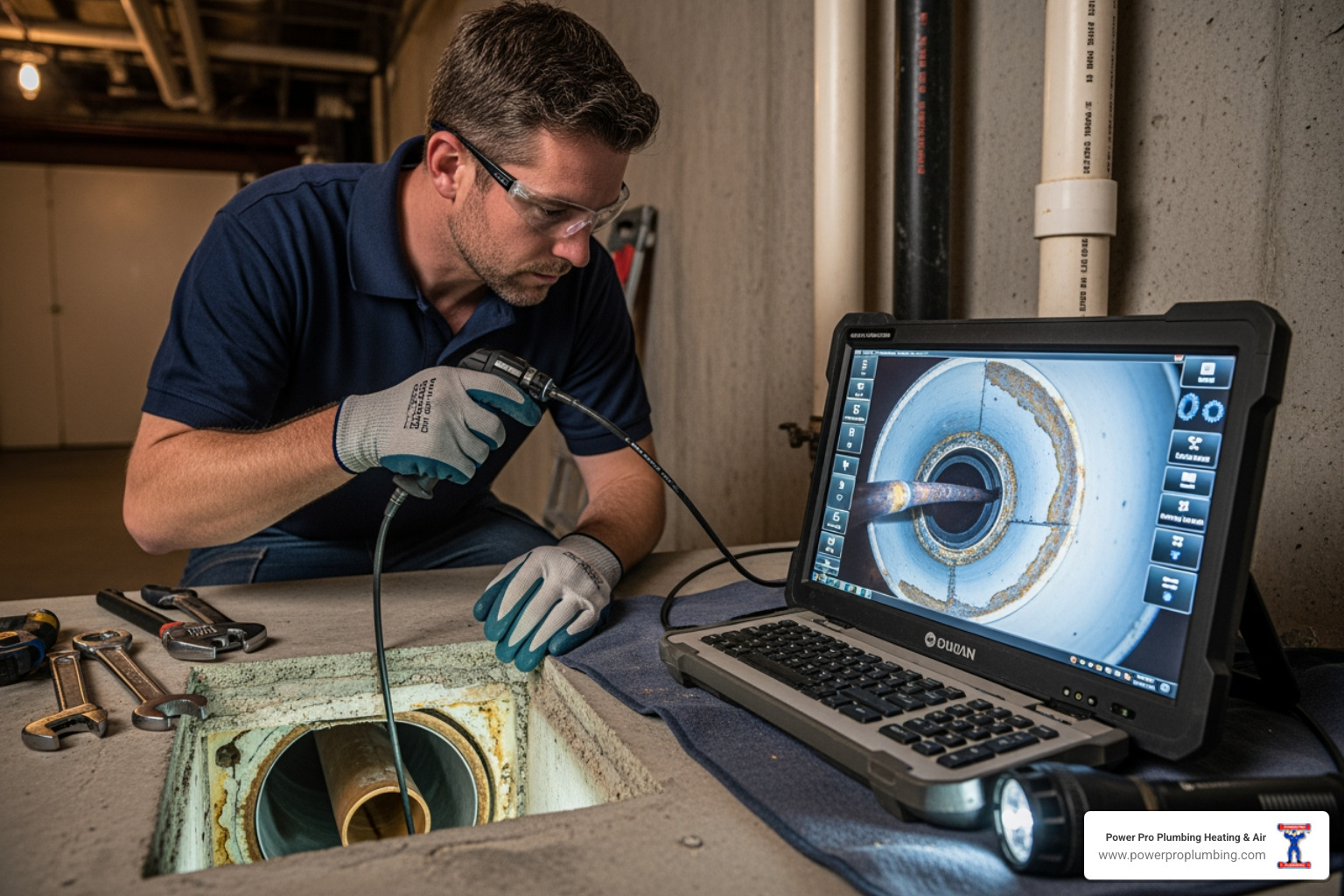
Why Water Pressure Matters in Long Beach's Historic Homes
Experiencing weak showers, slow-filling appliances, or a trickle from your faucets is a common frustration for homeowners in older Long Beach properties. The culprit is often hiding in an aging plumbing system.
Quick Answer: Most Common Causes
- Corroded galvanized pipes (common in pre-1960s homes)
- Mineral buildup from Long Beach's hard water
- Partially closed or faulty valves (main shutoff or pressure regulator)
- Hidden leaks (especially slab leaks)
- Municipal supply fluctuations or undersized main lines
When to Call a Pro: If you notice rusty water, sudden pressure drops, multiple affected fixtures, or suspect a leak, it's time for professional diagnosis.
Older Long Beach homes, particularly those built before the 1960s, often feature galvanized steel pipes that corrode from the inside out, narrowing the pipe diameter and choking water flow. Combined with Southern California's hard water, which deposits minerals like calcium and magnesium inside your lines, these aging systems face a perfect storm of pressure-robbing issues. Many classic Long Beach properties retain original plumbing that simply wasn't designed for modern water demands.
For homeowners across Southern California, expert plumbing services make all the difference when diagnosing and resolving persistent pressure problems. Learn more about comprehensive plumbing solutions or schedule a diagnostic appointment with a trusted local team.
Understanding whether your low pressure stems from a simple clogged aerator or corroded pipes requiring a full repipe is the first step toward a permanent solution. The good news is that most causes are identifiable, and knowing when to DIY versus when to call a plumber can save you time and money.
I'm Daniel Rodriguez, a second-generation tradesman with hands-on experience diagnosing low water pressure in Southern California's older homes. I've helped countless homeowners identify leaks, replace corroded lines, and restore strong, reliable water flow.

First Steps: How to Diagnose Your Water Pressure Problem
Before diving into the specific causes of low water pressure, let's diagnose the problem. Gathering clues now will save you time and frustration later.
The most important first step is to determine if the low pressure affects your entire home or just one fixture. This distinction points to either a simple local clog or a more significant system-wide issue.

If only one shower dribbles while other fixtures work fine, you're likely looking at a clogged showerhead. But if every faucet and shower has weak flow, the problem is upstream—in your main supply line, pipes, or pressure regulator.
Here are a few tests you can perform:
Bucket Test: Time how long it takes a problem fixture to fill a one-gallon jug. A healthy flow should take 20-30 seconds. If it takes a minute or more, your flow rate (GPM) is low.
Hot vs. Cold Water Test: If cold water pressure is strong but hot water is weak, the problem is likely your water heater (e.g., sediment buildup). If only cold water pressure is low, the issue is with the cold supply line.
Check with Neighbors: Especially in older Long Beach neighborhoods, if multiple homes have low pressure, the issue is likely with the municipal supply. This can save you from investigating your own plumbing unnecessarily.
For a precise diagnosis, use a pressure gauge on an outdoor hose bib. Ideal water pressure for Long Beach homes is 50 to 70 PSI. Below 40 PSI indicates a problem, while above 80 PSI can damage pipes and appliances.
When you test, measure both static pressure (no water running) and dynamic pressure (a shower running). A large drop between the two numbers suggests your system is struggling to keep up with demand.
Common causes in older Long Beach properties often trace back to mineral buildup from hard water and aging infrastructure. Southern California's water is notoriously hard, and when combined with old galvanized pipes, it creates a recipe for restricted flow. These diagnostic steps will help you decide your next move, whether it's a simple fix or a call to a professional.
Top 5 Causes of Low Water Pressure in Older Long Beach Homes
Low water pressure in older Long Beach homes usually stems from a few common culprits. Understanding these causes is the first step toward a solution. Here are the top five issues we see.
Aging & Corroded Galvanized Pipes

If your home was built before the 1960s, it likely has galvanized steel pipes. These pipes corrode internally over time, allowing rust and scale to build up and drastically reduce the pipe's diameter, restricting water flow. A key sign is rusty or discolored water, especially in the morning. This indicates that your galvanized pipes are corroding. Unfortunately, the only permanent solution for significant corrosion is repiping the affected sections with modern materials like copper or PEX. Our plumbing service solutions in Long Beach can help assess the corrosion and determine the best path forward.
Mineral Buildup from Long Beach's Hard Water
Southern California's water is hard, meaning it's full of minerals like calcium and magnesium. These minerals create scale buildup on fixtures and inside pipes. You may see white, crusty buildup on faucets and showerheads, but the same process is happening internally, narrowing your pipes and reducing flow over time. In older homes with already corroded pipes, the rough interior surfaces accelerate this mineral buildup, creating a dual threat to your water pressure. The result is clogged aerators, showerheads, and pipes that contribute to low pressure.
Faulty Valves or a Failing Pressure Regulator
Several valves control your home's water flow. The main shutoff valve can cause whole-house low pressure if not fully open. Likewise, individual fixture shutoff valves (under sinks, behind toilets) can cause localized issues if partially closed. The city's water meter valve can also be a factor, but you should never adjust it yourself—contact your water department if you suspect an issue.
A common culprit is the Pressure Reducing Valve (PRV). Installed to regulate high municipal pressure, a failing PRV can cause consistently low or fluctuating pressure. These valves wear out over time and are designed to keep pressure between 50-70 PSI. Symptoms of failure include pressure that changes daily or readings below 40 PSI. Diagnosing and replacing a PRV requires professional expertise.
Hidden Plumbing Leaks
A hidden leak can divert water away from your fixtures, causing a drop in pressure without any visible signs of water. In older Long Beach homes, slab leaks—leaks in pipes under the concrete foundation—are common. They are hidden, but signs include a drop in pressure and a higher water bill.
Other signs of a hidden leak include damp spots, mold, or the sound of running water when all fixtures are off. A water meter test can also confirm a leak: if the meter's reading changes while all water is off, you have a leak. If you suspect a leak, our plumbing repair services use advanced leak detection to pinpoint the location without unnecessary demolition, restoring pressure and preventing damage.
Municipal Supply Issues
Sometimes the problem isn't in your home but with the city's water system. Undersized main lines, high demand during peak hours, or municipal maintenance can cause pressure drops for an entire neighborhood. The easiest way to check is to ask your neighbors if they are experiencing similar issues. If so, contact the Long Beach Water Department to report the problem. While you can't fix the city's infrastructure, knowing the problem is external saves you from unnecessary repairs.
Your Action Plan: Solutions and When to Call a Professional
Once you've diagnosed the issue, it's time for a solution. Some low water pressure problems are simple DIY fixes, while others require a professional. Knowing the difference is key to avoiding frustration and further damage. Ignoring persistent low pressure can lead to higher water bills and appliance wear. Our plumbing services in Long Beach, CA can help you steer these challenges.
Simple DIY Checks for Low Water Pressure in Older Long Beach Homes
Before calling a pro, try these simple checks that can often resolve common issues:
Clean Faucet Aerators: These small screens get clogged with mineral deposits. Unscrew them, rinse any debris, and soak them in white vinegar for a few hours to dissolve buildup.
Clean Showerheads: Mineral buildup is a common cause of weak showers. Remove the showerhead and soak it in vinegar, or fill a plastic bag with vinegar and tie it around the head overnight.
Check Shutoff Valves: Ensure your main water shutoff valve is fully open (turned counter-clockwise). Also, check the individual valves under sinks and behind toilets to make sure they are completely open.
Flush Your Water Heater: Sediment can build up in the tank, especially in hard water areas, and affect hot water pressure. Flushing the tank annually can help, but if you're not comfortable doing it, a professional can handle it during a maintenance visit.
Signs You Need to Call a Plumber Immediately
Recognizing these red flags can prevent minor issues from becoming major disasters. Call a professional if you experience:
- A sudden, whole-house pressure drop: This could indicate a major leak or a main water line problem.
- No water at all: This requires immediate attention to diagnose a potential burst pipe or closed valve.
- Discolored or rusty water: This points to internal pipe corrosion, which is a water quality and plumbing health issue.
- Signs of a hidden leak: Damp spots, mold, or the sound of running water when everything is off suggest a leak that needs to be located and repaired.
- Consistently low or fluctuating pressure: If your pressure is below 40 psi or varies wildly, your Pressure Reducing Valve (PRV) may be failing, which requires a professional replacement.
If you've tried the simple fixes and the problem persists, or if you see any of these serious symptoms, it's time to contact us. Early intervention is always less costly than emergency repairs.
Professional Solutions for Low Water Pressure in Older Long Beach Homes

When DIY fixes aren't enough, professional tools and expertise are necessary. We start with thorough diagnostics to find the root cause.
Our video camera inspection lets us see inside your pipes to identify corrosion, mineral buildup, or blockages without guesswork. For suspected hidden leaks, especially slab leaks, we use electronic leak detection to find the precise location without destructive digging.
Based on our findings, we recommend a targeted solution:
Repiping with Copper or PEX: For homes with corroded galvanized pipes, this is the most effective permanent solution. Modern materials resist corrosion and mineral buildup, ensuring reliable pressure for decades.
PRV Adjustment or Replacement: If your Pressure Reducing Valve has failed, we can adjust or replace it to maintain the ideal 50-70 psi pressure, protecting your plumbing system.
Targeted Repairs: For localized clogs, we can use hydro-jetting to clear deposits or perform specific pipe repairs. If your main water supply line is undersized for modern needs, we can upgrade it to a larger diameter line.
Our goal is to provide a lasting solution that restores strong, reliable water pressure to your Long Beach home.
Frequently Asked Questions about Low Water Pressure
Why is the water pressure low in just my shower?
If only your shower has low pressure, it's a localized issue. The most common cause is a clogged showerhead due to mineral buildup from hard water. Soaking the showerhead in vinegar often resolves this. If that doesn't work, the issue could be a blocked shower cartridge (the internal valve) or a partially closed shutoff valve for that bathroom.
What is considered normal water pressure for a Long Beach home?
Normal water pressure for a Long Beach home is between 50-70 psi (pounds per square inch). This range provides strong flow without stressing your plumbing system. Pressure below 40 psi is considered low and needs investigation. Conversely, pressure over 80 psi is too high and can damage pipes and appliances, requiring a professional adjustment of your pressure-reducing valve.
Can I fix corroded pipes myself?
No, fixing corroded pipes is not a DIY job. This issue requires a partial or full repipe of your home's plumbing system, which involves cutting into walls, installing new copper or PEX lines, and ensuring all work is up to code. It demands specialized tools and knowledge to be done safely and correctly. Improper work can create health hazards and lead to major leaks. For a job this critical, always rely on a licensed and experienced plumber.
Conclusion: Restore Your Home's Water Pressure for Good
Living with low water pressure doesn't have to be your reality. As we've discussed, the common causes in older Long Beach homes range from corroded pipes and mineral buildup to faulty valves and hidden leaks. While some issues have simple DIY fixes, many problems lurking in older plumbing systems require professional diagnosis and repair.
Ignoring the problem can be costly, leading to higher water bills, premature appliance failure, and potential water damage. Rusty water is a clear warning sign that requires attention.
At Power Pro Plumbing Heating & Air, our experienced team knows how to diagnose and solve water pressure issues in the greater Los Angeles area. Whether it requires repiping with modern materials, replacing a worn-out pressure regulator, or finding a hidden leak, we have the tools and expertise to restore strong, reliable water pressure to your home.
Don't let another day go by with weak water flow. Your home deserves better.

